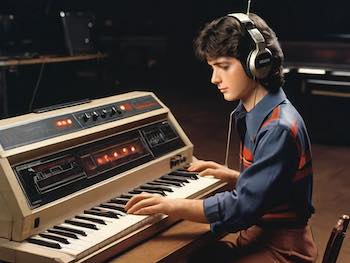Abstract: The story of my musical AI born in 1982 on a Sinclair ZX Spectrum, inexhaustible creator fallen into oblivion. Motivation ? An absence of instrumental talent contrasting with a fascination for sound synthesis and cosmic symphonies.
Sommaire
Spectral Intelligence
The 80s are the beginning of personal computing. I invest in 1982 in a Zinclair ZX Spectrum, one of the first consumer computers, which will soon be followed by Commodores, Thomson, Oric and other Atari. Unlike the more professional IBM and Apple PCs, these machines use an ordinary cassette tape recorder to store their data and are affordable for those on a tight budget. They are supplied with games of course, which will make them successful, but above all allow you to learn about programming. My ideas sparkle!
Fascinated since adolescence by amateur electronics, a few years earlier I fiddled with analog sound cards to install a personal plug-in synthesizer in a wooden case. I thus discovered a multitude of sounds that were amazing for the time, but now they have to be assembled into more digestible melodies. Devoid of musical training, I strum without talent on a keyboard and I need a more reliable performer. I easily program a sequencer on my Spectrum, then attack a much more ambitious project: designing a musical AI capable of compositions as long and varied as desired.
Melody by the minute
Basic being too slow, I also have to learn machine language, an arid series of 1s and 0s which is the natural syntax of the microprocessor and not at all that of our brains. To save time I only program routines in binary and assemble them with the easiest Basic. The Spectrum is connected to the synth with a digital/analog interface and…
The first attempts were somewhat discordant. I left a lot of initiative to the AI. It knows its music theory by heart but frequently uses random functions. Very experimental music! I had to complete its education: notions of chorus, solo, theme. Version 2.0 of the AI finally manages to output audible music, continuously if I so desire. Just as a weaving machine makes cloth by the yard, my enchanting machine produces melody by the minute, without ever getting tired.
Feather gliders
I let you listen. For these tracks, I plugged the Spectrum into a commercial synth lent by my sister’s musician buddy, a Yamaha DX7:
The Seagull
The seagull 2
Feather gliders
Within the explosion of electronic music
What happened to this ancient AI precursor? The studies of medicine devoured the time necessary for its development. On the other hand, I easily guessed the unspoken hostility of the musicians to whom I spoke about it. The fear of AI replacing the human artist is not new to the 21st century. Perhaps the coup de grace was the comment of a friend who played a bit of bass: “Sounds like elevator music”. The era of techno was long to wait…
I replaced the Spectrum with the first Macintosh 128K in 1985. Machine and Basic routines did not follow. My AI has never threatened the Top 50 productions, all well stereotyped and corseted in the fashion of the moment. To my great regret, because I found them very silly. But the 70s and 80s were also an explosion of melodic and sound creation, in progressive rock, krautrock and French electronic music —Richard Vimal, Space Art, Jean-Philippe Rykiel, etc. I fully found my musical happiness in my congeners.
The Decline of Composers
It is today that I regret the abandonment of this AI the most, because the following decades saw the collapse, in my opinion, of creativity among composers. Where are the successors to Pink Floyd, Genesis, Gong and Pete Townshend? It’s no coincidence that there are so many top bands doing the Pink Floyd revival, turning 70s music into a new classic repertoire that every music lover should know.
Certainly it is not easy to compose something new when all the melodies seem to have been created, just as it is not easy to write a new novel when all the stories seem to have been told. This encourages to establish new connections, to associate other sound, vocal, textual and rhythmic researches. Extend your imagination and not limit it with any instrument or imposed fashion. The machine I really wanted to build is the one that would transcribe the dazzling new-age symphonies composed unhindered in my head. But they fled with the years.
Soon musicBPT (Big Power of Trance)
Today the music scene has dried up and become so robotic at the level of composers that the field is clear for the next generation of really creative AI, such as MusicLM, an equivalent of chatGPT for music created by Google, not yet available to the general public, but of which you can have a preview here.
I expect to finally be able to ask my latest Mac, whose characteristics have changed a lot since the first 128K, to send me into the cosmic sound fragrances of which I dreamed as a teenager.
*

